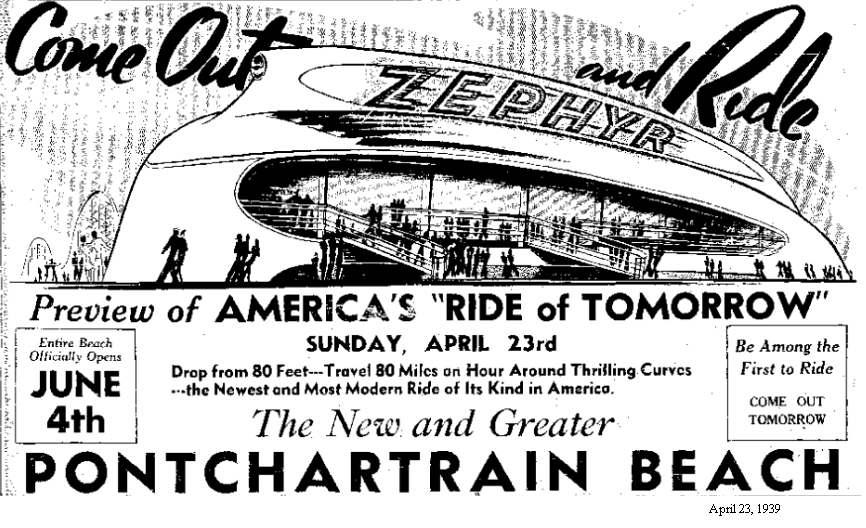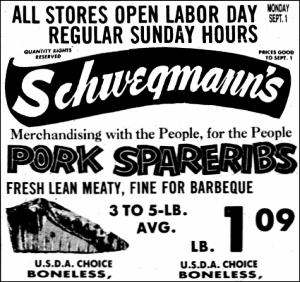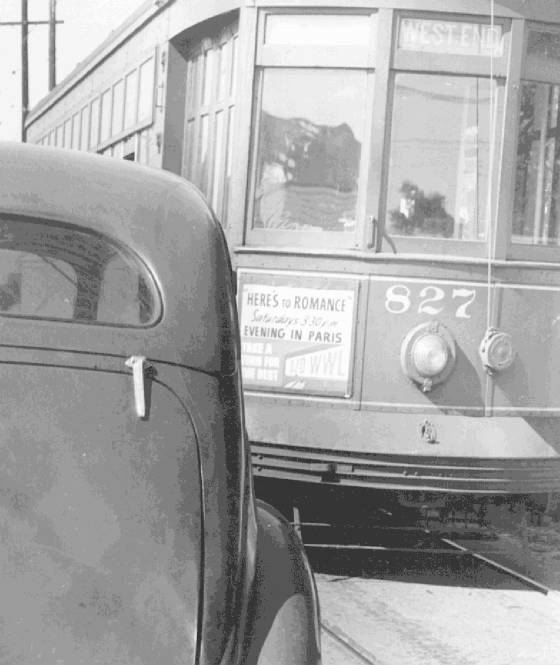|
Today in New Orleans History |
|
|
January 15



 

To receive an update for each day in New Orleans history,
join our facebook page - Today in New
Orleans History
Photo of the dedication of the Reverend Martin Luther King, Jr. monument on South Claiborne Ave. at St. Andrew St., January 15, 1981 (left to right) Rev. Climon Smith, Rev. Marie Galatas, and Rev. Samson
"Skip" Alexander.
Photo of groundbreaking for a new fire station at Robert and Clara Streets, January 15, 1958. Photograph by Photography by Plaideau.
Photo of Earhart Boulevard over the Washington Avenue Canal, January 15, 1954 [Photograph by Leon Trice] The Commission was comprised of 9 members (required to be qualified voters and property tax payers) appointed
by the mayor with the advice and consent of the Commission Council. The membership was increased in 1950 to 11 members.
The mayor himself also served ex-officio. The members served terms of 1, 2, 3, 4, 5, 6, 7, 8, or 9 years (10 and 11, after
1950) without compensation, with the Mayor designating the term of each member and naming the Chairman. The Commission
was authorized to appoint officers, create committees as necessary, and to establish whatever rules and regulations it needed
in order to conduct its business. It was also authorized to “select and employ such necessary persons to carry out
the purposes for which it [was] created.” The Commission met quarterly, but meetings could be held at any
time on the written request of any three members or on the call of the Chairman or mayor. It was also to make quarterly
reports to the Mayor and Council concerning its activities and its future recommendations. The Municipal Auditorium
was formally turned over to the City of New Orleans on January 15, 1930 and was dedicated on May
30, 1930. The Municipal Auditorium Commission ceased to exist with the passage of the Home Rule Charter
on May 1, 1954. Its functions were more or less continued by the Municpal Auditorium Advisory Board, which,
after December 1955, became the Municipal Auditorium Advisory Committee. Over the next decade or so, the Advisory Committee's
responsibilities and influence seems to have gradually diminished, and the Auditorium, for all practical purposes, came
to be managed by the Department of Property Management through a Managing Director. It is not clear exactly when the Advisory
Committee ceased to exist finally, but it may have been during the mid-late 1960's, when development of the Cultural Center
began. Among the building plans deposited in the City Archives by the Department of Safety and Permits are
10 sets of plans for various repairs, alterations, or additions to the Auditorium, dating from 1966 to 1997, including plans
for the transformation of the Auditorium into a temporary home for Harrah's Casino (1993-1994) and alterations for an arena
for the New Orleans Brass hockey team (1997). (Text above is from the New Orleans Public Library) By the 1960s, The Municipal Auditorium had become
obsolete for convention-exhibition purposes. The modern center for such activities was to face
the Mississippi River, relate to the recently completed International Trade Mart Tower, and
tie these two elements together by means of a spacious pedestrian plaza. The designated site,
six city blocks, was bounded by Canal, Poydras, South Peters Street, and what is now Convention Center Boulevard.
The 1964 photo on the right shows the streetcar turn at the foot of Canal Street, the Liberty
Monument, and the three and four-story buildings dating from mid nineteenth-century which would
be demolished to make way for the Rivergate. Left of center is a partially demolished warehouse
dating from c. 1905. (Photo by Rolland Golden; printed by Robert S. Brantley, Historic New Orleans
Collection.) Although the Rivergate was
conceived and designed as a convention-exhibition facility, it was also used as the venue
for Mardi Gras balls, high school graduations, and the lying in state of New Orleans native
Mahalia Jackson in 1972). But like the Municipal Auditorium, the Rivergate became obsolete in its usefulness as
a convention and exhibition center. The Ernest N. Morial Convention Center was being planned
in 1978. As of 2006, it has about 1.1 million square feet of exhibit space, covering almost
11 blocks, and over 3 million square feet of total space. It is the 5th-largest facility
of its kind in the United States and would dwarf the old Rivergate. Some events which occured in the Municipal
Auditorium, aside from the graduation ceremonies of countless New Orleans area high school students (myself included) were
Carnival balls, circuses, conventions, athletic events, and more. Some of the notable ones include: Boxer Wilfred
"Willie" Raleigh Pastrano made his professional debut at age 16 on September
8, 1951 against Leo Bayard at Municipal Auditorium and won the light heavyweight championship there on
April 22 -- 26, 1970 -- New Orleans Jazz and Heritage Festival
held at Beauregard Square (now Armstrong Park) and the Municipal Auditorium. Music from
noon to midnight. Duke Ellington, Mahalia Jackson, Pete Fountain, Al Hirt, Preservation
Hall Band and "Hundreds of Others" according to advertising posters. Produced by George Wein. Tickets
available at Werlein's, 605 Canal Street. Dorothy "Dottie" Lamour came home
to celebrate her 50th birthday on December 10, 1967 while on a tour starring in "Hello, Dolly!"
which ran at the Municipal Auditorium on Saturday, December 16. Led Zeppelin concert -- May 14, 1973.
Paul Capdevielle was educated at the Jesuit’s College in New Orleans from which he was graduated in 1861. He served
with credit in the War between the States, enlisting in the New Orleans Guard Regiment of Infantry, but in 1862 joined Boone’s
Louisiana Artillery, and was wounded at Port Hudson. After the close of the war he returned to civil life, taking
up the first employment that offered itself, studied law in April 1868 was graduated from Louisiana State University. In
1892, he gave up law to accept the presidency of the Merchant’s Insurance Company. He served as its President for
sixteen years, until it was liquidated and sold. His political history began in 1877 when he was appointed to the
School Board. Later he was a member of the Orleans Levee Board, a Commissioner of Prisons and Asylums and Chairman of the
Finance Committee of the drainage commission. Mr. Capdevielle was an outstanding figure in Louisiana politics from the
time of his election as Mayor of New Orleans in 1899. He was appointed auditor of Public Accounts in 1904, and re-elected
three times, and held this office up to the time of his death. He survived the political storms attending the fall of the
state administrations, the last in 1920, when Governor Parker was swept into office. The Flower administration was
a turning point in the history of New Orleans. It closed one epoch and opened another. With it began the period of commercial
prosperity which extends into the present time. Mayor Capdevielle’s administration was noted for two events,
both inseparably connected with the beginning of New Orleans’ industrial development; the installation of the modern
sewerage system and the organization of the Public Belt Railroad. The Board of Port Commissioners also began to function
actively during this period. City Park stands as a monument to his energy and civic spirit. The upbuilding of the
park was his constant care, and he served continuously as President of the City Park Improvement Association for more than
two decades, holding the office at the time of his death. The new administration went into office May 9, 1900, at
the beginning of the twentieth century when a wave of prosperity passed over the country and was felt in New Orleans. Mayor
Capdevielle in his inaugural address spoke of the drainage system about to be constructed and stated if the city desired
to have its own electric light plant it could do so without great additional cost by using the power house of the drainage
system. The contract to erect a modern jail, to be called the House of Detention, was awarded for $112,800 and
the site of the old Marine Hospital, on Tulane Avenue and Broad Street, was selected. The Henry Clay statue, being
in the way of safe operations of the street cars, was removed from Canal Street to the Lafayette Square on January
12, 1901. The consolidation of various street railways into one corporation under the name of the New Orleans
Railways Company was an important factor of the years 1901-1902. On May 1, 1901, New Orleans was
honored by the visit of the President of the United States, William McKinley, accompanied by Mrs. McKinley and Secretaries
John Hay, Charles Emory Smith, and E. A. Hitchcock. He was received in the Cabildo by the Governor of Louisiana, attended
by his staff in full uniform. The bells of the Cathedral of St. Louis announced the arrival of the President and his cabinet,
escorted by Mayor Paul Capdevielle, and a committee of distinguished citizens. As the cortege entered the Supreme Court
Hall, Chairman Zacharie announced in a loud voice “The President,” and the assembly arose and remained standing
while the Chief Justice conducted the President to a seat of honor at his right on the Supreme Court Bench. The Governor
of Louisiana took a seat on the left of the Chief Justice, and the Mayor of New Orleans the one on the right of the President,
the Justices occupying seats immediately in the rear of the bench. Chairman Zacharie then conducted the members of the
cabinet and their wives to places on the left of the dais, where a seat, filled with roses, had been reserved for Mrs. William
McKinley, who, at the last moment, was too ill to attend. In 1873, Paul Capdevielle married in New Orleans, Miss
Emma Larue, who died several years ago. Three sons and two daughters blessed this union; the sons are Christian, Auguste
and Paul, Jr., and the daughters are the Misses Edith and Yvonne Capdevielle. Paul Capdevielle was found dead at
his home in Bay St. Louis, Mississippi, August 13, 1922, following a long illness, at the age of eighty
years and six months and is buried in St. Louis Cemetery No. 2. Besides his children, a sister, Mrs. Virginia Buddecke and
five grandchildren also survived. (From the New Orleans Public Library) |
|
|

To receive an update for each day in New Orleans history,
join our facebook page - Today in New
Orleans History.
Analytics |


